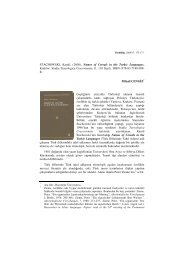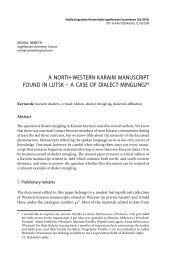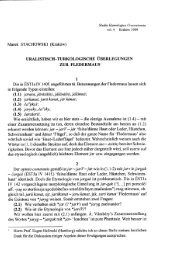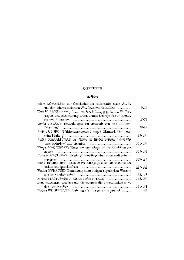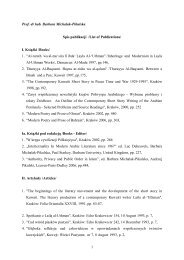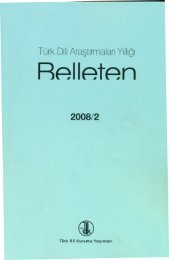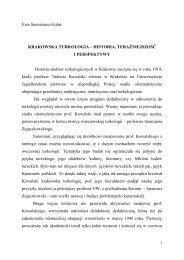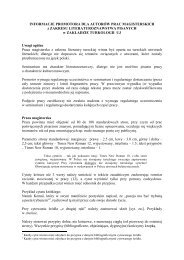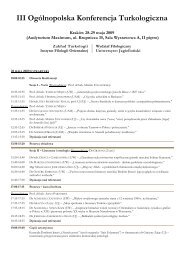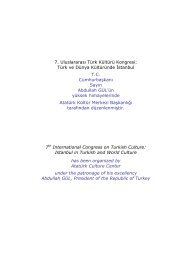Millet || dary 37taryk MTkc.KD: طارغ || Uzb.: Lap<strong>in</strong> 1899, (‘крупноe’) Smolenskij 1912teri Uyg.: ‘1. gra<strong>in</strong>; 2. millet’ VEWTteriγ Uyg.: ÈSTJaterik Uyg.: R III 850m, VEWTteriq Uyg.: Menges 1933, تیریق RUjgS, Dmitrieva 1972tyră Čuv.: VEWT ‘gra<strong>in</strong>; millet’, Eren 1999 ‘cereal’? tyryq Uyg.: تریق Raquette 1927languages:Az.: dary || Blk.: tary || Bšk.: tary || Com.: tary [tari] || CTat.: dary || Čag.: tarig, tarik,taryg || Čuv.: tyră || Gag.: dary || KarC.: dary, tary || Khak.: taryg || Kirg.: tarū, tary ||Kklp.: tary || Kmk.: tari, tarī, tary || Krč.: tary || Krč.Blk.: tary || Kzk.: tary || MTkc.:taryg, taryk || MTkc.H: tary || MTkc.IM: taryg || MTkc.KD: taru || MTkc.MK: taryg ||Nog.: tary || OTkc.: tarik, taryg || Ott.: daru, dary, tary || OUyg.: taraγ || SarUyg.: taryg ||Tat.: dari, tary || Tat.Gr.: tary || Tel.: taru, tarū, tary || Tksh.: dary || Tob.: tary || Trkm.:dary, taryg || Uyg.: tariq, taryγ, teri, teriγ, terik, teriq, ? tyryq || Uzb.: tarik, tariq, taryketymology:1960: VGAS 62: OTkc. taryg ‘Ernte, Getreide’ = Mo. tarijan ‘Feld, Saat’, MMo. tarijad‘Saaten, Getreide’, Xlx. tariā ‘Saat’1969: VEWT: ~ Mo. tarijan ‘sow<strong>in</strong>g; cereal; land, soil; gra<strong>in</strong>’1972: Clauson: < tary ‘to cultivate land’; d- by contam<strong>in</strong>ation with Pers. dārū ‘medic<strong>in</strong>e,drug’1972: Dmitrieva: OTkc. taryg ‘millet; gra<strong>in</strong>; grass’ < tary ‘to sow’ + -g1974: ÈSTJa: 1. Forms without -g: < tar- ‘to cultivate land; to sow’ + -y; 2. Forms with-g: < tar-y- ‘to sow’ or like 1.1979: Dmitrieva: < tary ‘to sow’ + -yg ‘result, outcome’Tuv. tarā, Oyr. tarān, Tat., Brb. taran ‘millet’ < Mo. tarijan ‘gra<strong>in</strong>’, where -ān < -γan1999: Eren: < tary ‘(ek<strong>in</strong>) ekmek’ + -ğ2002: Tietze: < OTkc. taryg (after Clauson 1972)commentary:This word has relatively uniform mean<strong>in</strong>gs <strong>in</strong> all <strong>the</strong> languages (after ÈSTJa):1. The form without -g apart from ‘millet’ can mean: ‘gra<strong>in</strong>’, ‘cereal’, ‘groats’ and <strong>the</strong>like, and o<strong>the</strong>r cereals. All <strong>the</strong>se mean<strong>in</strong>gs are understandable given <strong>the</strong> etymologyand, except for <strong>the</strong> last group, are <strong>of</strong> a very limited range (at most one <strong>of</strong> <strong>the</strong>follow<strong>in</strong>g languages: Oyr., T<strong>of</strong>., Tuv.).For Tksh.dial. mean<strong>in</strong>g <strong>of</strong> ‘corn’, cf. mysyr, <strong>the</strong> commentary at <strong>the</strong> beg<strong>in</strong>n<strong>in</strong>g <strong>of</strong>this chapter, and čüžgün, jasymuk and jügür.2. The form with -g means also ‘wheat’, ‘barley’, ‘gra<strong>in</strong>’, ‘cereal’, ‘fodder’, ‘sow<strong>in</strong>g’,‘crops’, ‘harvest’, ‘cultivation’, ‘descendant’ and <strong>the</strong> like. All <strong>the</strong>se mean<strong>in</strong>gs areolder and, except for <strong>the</strong> last possibility which is not fully clear, understandable <strong>in</strong>view <strong>of</strong> <strong>the</strong> etymology.The morphological structure <strong>of</strong> this word and its deverbal orig<strong>in</strong> are quite obvious. Theproblematic part is <strong>the</strong> f<strong>in</strong>al vowel <strong>of</strong> <strong>the</strong> verbal stem (see tara and taragan). It has been,
38 <strong>in</strong>däü || Millethowever, solved by ÈSTJa <strong>in</strong> a very conv<strong>in</strong>c<strong>in</strong>g way by <strong>in</strong>terpret<strong>in</strong>g -y ~ -a as a denom<strong>in</strong>alsuffix and deriv<strong>in</strong>g <strong>the</strong> verbal tary- ~ tara- from nom<strong>in</strong>al *tar ‘sow<strong>in</strong>g; harvest; field’, whichat <strong>the</strong> same time expla<strong>in</strong>s dary (< tar-), taryg (< tar-(y-) ) and such forms as Sag. and o<strong>the</strong>rstarlaγ ‘fodder’, and OUyg. taraγ ‘cereal’ and <strong>the</strong> like (< tar-a-). Cf. tarā, taragan.The contam<strong>in</strong>ation with Pers. darū ‘medic<strong>in</strong>e, drug’ assumed by Clauson 1979 toexpla<strong>in</strong> <strong>the</strong> voiced anlaut <strong>in</strong> Oghuz. is, as has been justly remarked by ÈSTJa, not verylikely (although it seems to us that <strong>the</strong> semantic difficulty, not mentioned by ÈSTJa,migh be even more important than <strong>the</strong> fact that <strong>the</strong> Pers. dārū is unknown to SWTkc. languages), and moreover, absolutely superfluous s<strong>in</strong>ce <strong>the</strong> voic<strong>in</strong>g <strong>of</strong> occlusives <strong>in</strong>anlaut is a regular change <strong>in</strong> <strong>the</strong> Oghuz. languages, and <strong>the</strong> d- forms <strong>in</strong> Kipč. (KarC.and Tat.) may be easily, and with a very high degree <strong>of</strong> plausibility, expla<strong>in</strong>ed by anOghuz. <strong>in</strong>fluence or borrow<strong>in</strong>g. 26For fur<strong>the</strong>r bibliography cf. first <strong>of</strong> all ÈSTJa and Eren 1999.Dmitireva 1979: 163 has suggested that <strong>the</strong> fact that this name derives from <strong>the</strong> verb‘to sow’ might be regarded as a testimony that millet was <strong>the</strong> first cereal cultivated by <strong>the</strong>Tkc. peoples. But, it might also not be true s<strong>in</strong>ce, she cont<strong>in</strong>ues, D. tarwe ‘wheat’. AS tare‘tare, vetch’ et al. < [sic] OInd. dūrvā ‘millet’ < PIE *der- ‘to rip <strong>of</strong>f; to sk<strong>in</strong>’. This seemsto us to be quite poor reason<strong>in</strong>g. OInd. and <strong>the</strong> Grmc. languages are only very remotelyrelated with one ano<strong>the</strong>r, and <strong>the</strong> fact that what orig<strong>in</strong>ally was one word now has differentmean<strong>in</strong>gs is not actually very surpris<strong>in</strong>g. The Tkc. languages are related much moreclosely, and dary has a very uniform mean<strong>in</strong>g (with a few exceptions, see above) <strong>of</strong> ‘millet’;only <strong>in</strong> a few <strong>of</strong> <strong>the</strong> languages does it <strong>in</strong>clude ‘gra<strong>in</strong>’, ’cereal’ and <strong>the</strong> like. The situationis <strong>the</strong>n, quite different. However, even <strong>in</strong> <strong>the</strong>se, much more favourable conditions we donot believe – as Dmitrieva apparently does – that it is possible to establish which was <strong>the</strong>first cereal cultivated by <strong>the</strong> Tkc. peoples us<strong>in</strong>g only <strong>the</strong> etymology <strong>of</strong> one word. Onecould equally well suppose that <strong>the</strong> first cereal was named with a borrow<strong>in</strong>g ra<strong>the</strong>r thana native word, and such a guess could not be proved any more.Cf. also (-)tarā and taragan.<strong>in</strong>däüforms:<strong>in</strong>däü Čag.: اینداو ‘[…] родъ проса, изъ котораго приготовляeтся масло […]’ R I 1449metymology: R I 1449m: < <strong>in</strong>dä+-ücommentary:The etymology <strong>of</strong>fered by Radl<strong>of</strong>f is ra<strong>the</strong>r odd. <strong>in</strong>dä appears <strong>in</strong> various languages, butwith <strong>the</strong> mean<strong>in</strong>g <strong>of</strong> ‘to call, to summon’. Thus, <strong>the</strong> semantic connection – if it evenexists – would require a comprehensive commentary, which Radl<strong>of</strong>f fails to provide.Regrettably, we cannot <strong>of</strong>fer a more conv<strong>in</strong>c<strong>in</strong>g proposition, ei<strong>the</strong>r.26 They could also be understood as <strong>the</strong> result <strong>of</strong> an assimilation to <strong>the</strong> next consonant, i.e. t-r >d-r, which is however not very conv<strong>in</strong>c<strong>in</strong>g s<strong>in</strong>ce such a change is characteristic <strong>of</strong> Oghuz., notKipč. languages.



